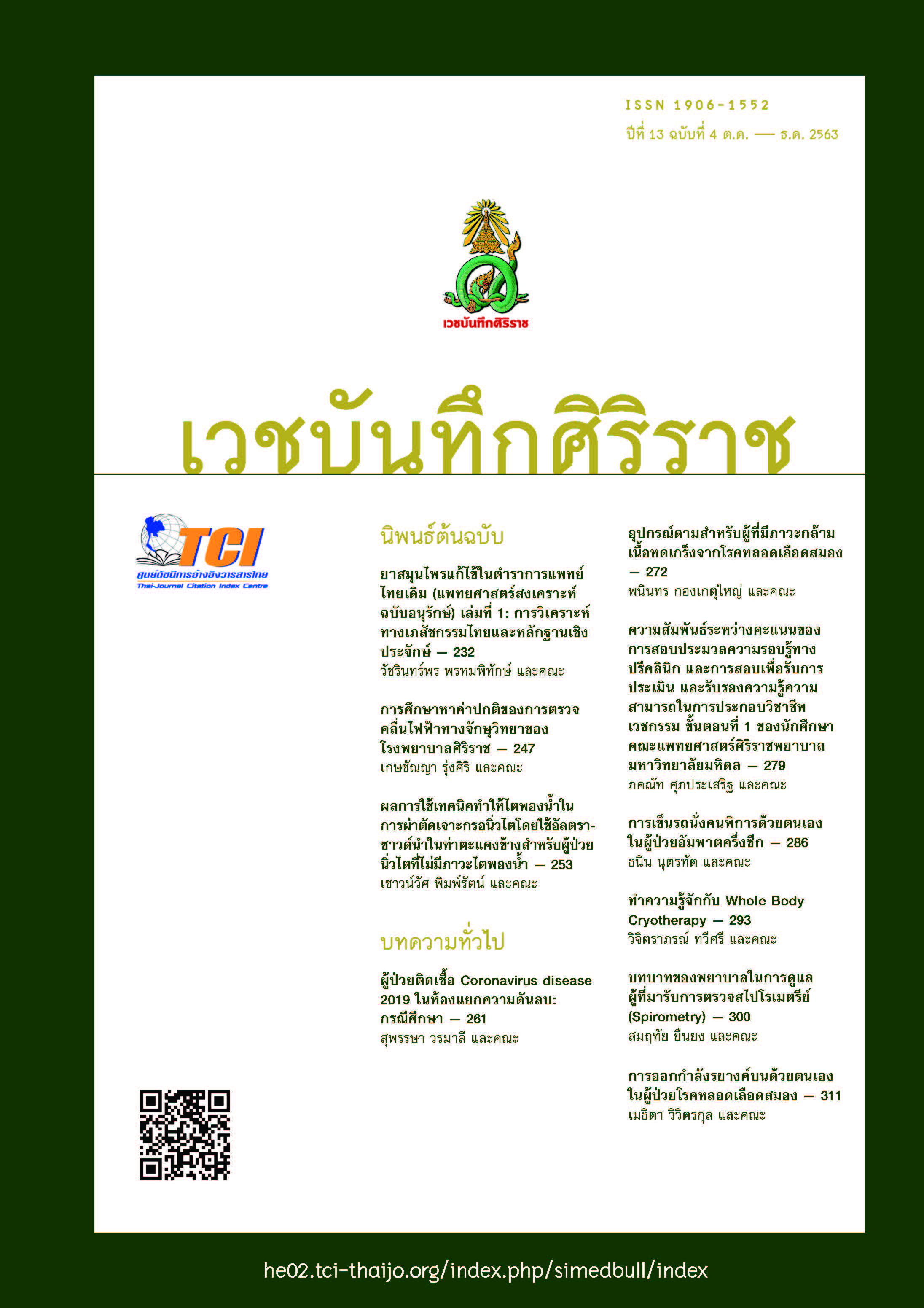Outcomes of Artificial Hydronephrosis in Ultrasound Guided Percutaneous Nephrolithotomy in Lateral Position in Non-Hydronephrotic Renal Stones
Main Article Content
Abstract
Abstract
Objective: To evaluate outcomes of artificial hydronephrosis technique in ultrasound guided percutaneous nephrolithotomy in lateral position in the treatment of non-hydronephrotic renal stones.
Methods: Between October 2016 and August 2020, eighty-five non hydronephrotic renal stone cases who underwent pure ultrasound guided percutaneous nephrostomy with artificial hydronephrosis technique in Buriram Hospital were reviewed. The outcomes, including stone-free rates, operative times, length of hospital stay, and complications were collected.
Results: A total of 85 patients composed this study, there were 43 men and 42 women, with average age 57.2 (21-87) years. Mean body mass index was 23.7±3.7 kg/m2. Mean stone size was 48.2±16.6mm, and mean stone surface area was 1299.1±816 mm2. The success rate of renal access was 98.8 %. Stone free rate was 64.7 %. Mean stone surface clearance rate was 97.3±6.0. The complications in our study were presented unsuccessful renal access in 1 case, requirement for blood transfusion in 6 cases (7.1%), transient postoperative fever 26 cases (30.6%), and urosepsis was found in 2 cases (2.6%). Mean operative time was 113.4±42.2 minutes and length of stay was 8.6±2.9 days.
Conclusions: This study found that artificial hydronephrosis were reduced the limitation of the treatment of non-hydronephrotic renal stones with ultrasound guide percutaneous nephrolithotomy. The stone-free rates and stone surface clearance rate were satisfied. The low postoperative complications and absent of radiation exposure in patients and medical personnel were considered.
Article Details
References
1. Nualyong C, Sathidmangkang S, Woranisarakul V, Taweemonkongsap T, Chotikawanich E. Comparison of the outcomes for retrograde intrarenal surgery (RIRS) and percutaneous nephrolithotomy (PCNL) in the treatment of renal stones more than 2 centimeters. Thai J Urol. 2019 Jun 2;40(1):9–14.
2. Pitujaturont K, Choonhaklai V. Early experience of supine PCNL in Rajavithi Hospital. Thai J Urol. 2014 Dec 1;35(2):1–11.
3. Somdee W, Sathitkarnmanee T, Palachewa K, Jeerararuensak W, Simajareuk S, Thincheelong V, et al. Anesthesia Related Pneumothorax, Hydrothorax or Hemothorax in Patients Undergoing Percutaneous Nephrolithotomy in Srinagarind Hospital. Srinagarind Med J. 2013;28(2):178–83.
4. Liu Q, Zhou L, Cai X, Jin T, Wang K. Fluoroscopy versus ultrasound for image guidance during percutaneous nephrolithotomy: a systematic review and meta-analysis. Urolithiasis. 2017 Oct;45(5):481–7.
5. Chu C, Masic S, Usawachintachit M, Hu W, Yang W, Stoller M, et al. Ultrasound-Guided Renal Access for Percutaneous Nephrolithotomy: A Description of Three Novel Ultrasound-Guided Needle Techniques. J Endourol. 2016 Feb 1;30(2):153–8.
6. Beiko D, Razvi H, Bhojani N, Bjazevic J, Bayne DB, Tzou DT, et al. Techniques – Ultrasound-guided percutaneous nephrolithotomy: How we do it. Can Urol Assoc J. 2020 Mar;14(3):E104–10.
7. Lojanapiwat B. The ideal puncture approach for PCNL: Fluoroscopy, ultrasound or endoscopy? Indian J Urol IJU J Urol Soc India. 2013;29(3):208–13.
8. Baralo B, Samson P, Hoenig D, Smith A. Percutaneous kidney stone surgery and radiation exposure: A review. Asian J Urol. 2020 Jan;7(1):10–7.
9. AbdelRazek M, Hassan A, AbdelKader MS, Abolyosr A. SWL outcome in artificial hydronephrotic vs. non-hydronephrotic kidney for preschool children with high-density renal stones. World J Urol. 2019 May;37(5):937–41.
10. Namdev R. Hydronephrosis (grading) | Radiology Reference Article | Radiopaedia.org [Internet]. Radiopaedia. [cited 2020 Jul 28]. Available from: https://radiopaedia.org/articles/hydronephrosis-grading-1
11. Lingeman JE, Coury TA, Newman DM, Kahnoski RJ, Mertz JH, Mosbaugh PG, et al. Comparison of results and morbidity of percutaneous nephrostolithotomy and extracorporeal shock wave lithotripsy. J Urol. 1987 Sep;138(3):485–90.
12. Clavien PA, Barkun J, de Oliveira ML, Vauthey JN, Dindo D, Schulick RD, et al. The Clavien-Dindo Classification of Surgical Complications: Five-Year Experience. Ann Surg. 2009 Aug;250(2):187–196.
13. Basiri A, Kashi AH, Zeinali M, Nasiri M, Sarhangnejad R, Valipour R. Ultrasound - guided access during percutaneous nephrolithotomy: entering desired calyx with appropriate entry site and angle. Int Braz J Urol Off J Braz Soc Urol. 2016;42(6):1160–7.
14. Usawachintachit M, Tzou DT, Hu W, Li J, Chi T. X-ray–free Ultrasound-guided Percutaneous Nephrolithotomy: How to Select the Right Patient? Urology. 2017 Feb;100:38–44.
15. Cabrera F, Preminger GM, Lipkin ME. As low as reasonably achievable: Methods for reducing radiation exposure during the management of renal and ureteral stones. Indian J Urol IJU J Urol Soc India. 2014;30(1):55–9.
16. Usawachintachit M, Masic S, Allen IE, Li J, Chi T. Adopting Ultrasound Guidance for Prone Percutaneous Nephrolithotomy: Evaluating the Learning Curve for the Experienced Surgeon. J Endourol. 2016 Aug 1;30(8):856–63.
17. Zhang FB-Y, Lin W-R, Yang S, Hsu J-M, Chang H-K, Chen M, et al. Outcomes of percutaneous nephrolithotomy versus open stone surgery for patients with staghorn calculi. Urol Sci. 2017 Jun 1;28(2):97–100.
18. Lertkachatarn S. Percutaneous nephrolithotomy (PCNL) : Ultrasound guided puncture. J Prapokklao Hosp Clin Med Educ Cent. 2005;22(4):189–96.
19. Tagawa M, Ogata A, Hamano T. Pre- and/or Intra-Operative Prescription of Diuretics, but Not Renin-Angiotensin-System Inhibitors, Is Significantly Associated with Acute Kidney Injury after Non-Cardiac Surgery: A Retrospective Cohort Study. PLoS ONE [Internet]. 2015 Jul 6 [cited 2020 Jul 29];10(7). Available from: https://www.ncbi.nlm.nih.gov/pmc/articles/PMC4492997/
20. Gutierrez J, Smith A, Geavlete P, Shah H, Kural AR, de Sio M, et al. Urinary tract infections and post-operative fever in percutaneous nephrolithotomy. World J Urol. 2013;31(5):1135–40.
21. Lertkachatarn S. Percutaneous nephrolithotomy (PCNL) for staghorn calculi in lateral position. J Prapokklao Hosp Clin Med Educ Cent. 2008;25(2 Suppl.):35–43.


